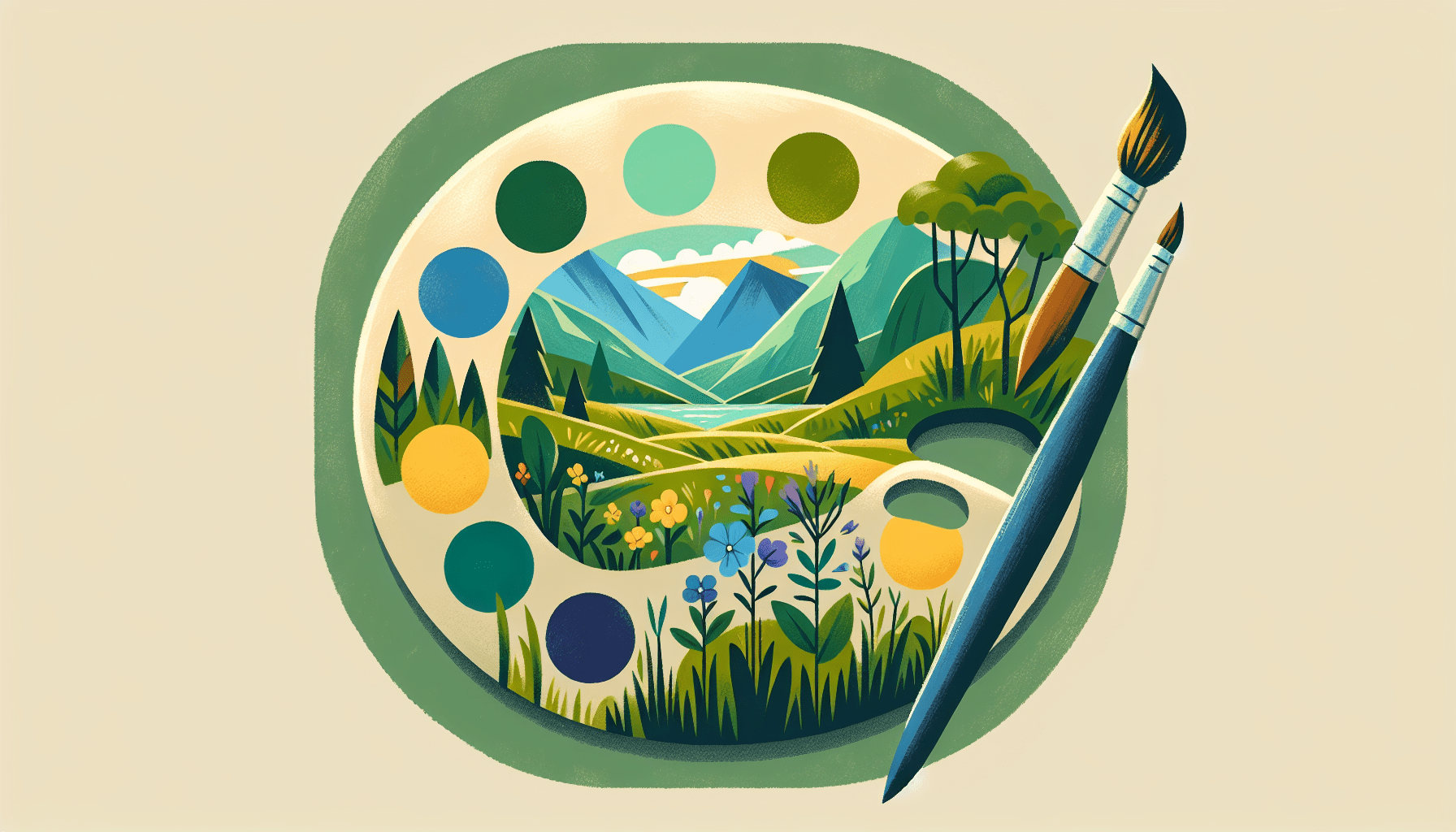Have you ever wanted to try your hand at painting landscapes but felt intimidated by the complexity of the scenes? Don’t worry! In this guide, we will walk you through some simple landscapes that are perfect for beginners. Whether you’re a total novice or just looking to brush up on your skills, these easy painting ideas will help you get started on your artistic journey.
Gathering Your Supplies
Before we dive into painting our first landscape, let’s talk about the supplies you’ll need. Here’s a quick breakdown of the essential items you should have on hand:
| Supplies | Description |
|---|---|
| Paintbrushes | Different sizes for different strokes |
| Canvas or Paper | Surface to paint on |
| Acrylic Paints | Easy to use and quick-drying |
| Palette | Mixing and blending colors |
| Water cup | For rinsing your brushes |
| Paper towels | To wipe your brushes and clean up spills |
Gathering your supplies before you start painting will ensure a smooth and enjoyable creative process. Once you have everything you need, it’s time to move on to our first simple landscape.
The Serene Meadow
Imagine yourself sitting in a peaceful meadow, surrounded by blooming flowers and tall grass swaying in the breeze. This scene is perfect for beginners as it allows you to experiment with different brush strokes and colors while keeping things uncomplicated.
To create your own serene meadow painting, start by:
- Sketching the Basic Shapes: Outline the shape of the trees, flowers, and grass using a light pencil.
- Blocking in the Colors: Fill in the sky with a light blue, then add patches of green for the grass and splashes of color for the flowers.
- Adding Details: Use smaller brushes to add details like tree trunks, flower petals, and grass blades.
- Blending and Texturing: Blend colors together to create a seamless transition between different elements in your painting.
By following these steps, you can create a beautiful and calming landscape that will inspire you to keep painting.
Understanding Color Theory
Color theory is a fundamental aspect of painting, and understanding how colors work together is crucial for creating compelling landscapes. Here are some essential concepts to keep in mind:
Color Wheel Basics
The color wheel is a tool that helps artists understand how colors relate to each other. It consists of three primary colors (red, blue, and yellow), three secondary colors (orange, green, and purple), and six tertiary colors that are created by mixing primary and secondary colors.
Color Harmony
Color harmony refers to the pleasing combination of colors in a painting. Some common color harmonies include complementary colors (colors opposite each other on the color wheel), analogous colors (colors next to each other on the color wheel), and triadic colors (three colors equally spaced on the color wheel).
Value and Saturation
Value refers to the lightness or darkness of a color, while saturation refers to the intensity or purity of a color. Understanding how value and saturation interact can help you create depth and dimension in your landscapes.
By mastering these basic principles of color theory, you can elevate your landscape paintings and create visually appealing compositions.
Techniques for Creating Depth
One of the key elements of a compelling landscape painting is creating a sense of depth and distance. Here are some techniques you can use to make your landscapes more three-dimensional:
Atmospheric Perspective
Atmospheric perspective refers to the way that objects appear to change in color and clarity as they recede into the distance. To create this effect in your paintings, use lighter and cooler colors for objects in the background and darker, warmer colors for objects in the foreground.
Overlapping Objects
Another effective way to convey depth in your landscapes is by overlapping objects. By placing one object in front of another, you can create a sense of space and distance between different elements in your painting.
Linear Perspective
Linear perspective is a method of creating the illusion of depth by using converging lines to draw the viewer’s eye into the distance. By incorporating vanishing points and perspective lines into your landscapes, you can create a realistic sense of space and scale.
By incorporating these techniques into your landscape paintings, you can add depth and dimension to your artwork and create visually dynamic compositions.
Tips for Creating Realistic Textures
Textures are an important element of landscape paintings as they help bring your scenes to life and create a sense of tactile realism. Here are some tips for creating realistic textures in your landscapes:
Dry Brush Technique
The dry brush technique involves using a minimal amount of paint on a dry brush to create a textured effect. By lightly dragging the brush over the surface of your painting, you can mimic the look of rough tree bark, rocky cliffs, or other natural textures.
Impasto Technique
The impasto technique involves applying thick, heavy strokes of paint to create a raised, textured surface. This technique is great for creating the illusion of texture in your landscapes and adding a tactile quality to your paintings.
Sgraffito Technique
The sgraffito technique involves scratching or scraping away layers of paint to reveal the layers underneath. This technique is great for adding fine details to your paintings, such as grass blades, tree branches, or other intricate textures.
By experimenting with different painting techniques and tools, you can create a variety of textures in your landscapes and bring your scenes to life in a dynamic and engaging way.
Choosing the Right Composition
Composition is a crucial aspect of landscape painting as it determines the overall layout and balance of your artwork. Here are some tips for choosing the right composition for your landscapes:
Rule of Thirds
The rule of thirds is a composition technique that involves dividing your canvas into nine equal parts using two horizontal and two vertical lines. By placing your focal points or key elements along these lines or at their intersections, you can create a visually appealing and balanced composition.
Leading Lines
Leading lines are lines within your composition that lead the viewer’s eye into the scene and towards the focal point. By incorporating diagonal lines, pathways, or curves into your landscapes, you can create a sense of movement and flow that draws the viewer into the painting.
Framing Devices
Framing devices are elements within your composition that help frame or focus attention on the main subject. This could include trees, archways, doorways, or other elements that create a sense of depth and perspective in your landscapes.
By considering these composition techniques and experimenting with different arrangements of elements in your landscapes, you can create visually compelling and engaging paintings that capture the beauty of the natural world.
Adding Final Touches
Once you’ve completed your landscape painting, it’s time to add the finishing touches that will bring your artwork to life and enhance its overall impact. Here are some final touches you can consider:
Varnishing
Applying a coat of varnish to your finished painting not only protects it from dust and dirt but also enhances the colors and adds a professional finish to your artwork. Choose a varnish that is compatible with your painting medium (e.g., acrylic, oil) and follow the manufacturer’s instructions for best results.
Signature
Don’t forget to sign your painting! Adding your signature to the front or back of your artwork is not only a way to claim ownership but also adds a personal touch and identifies you as the artist.
Display
Once your painting is complete, consider how you want to display it in your home or studio. Whether you choose to frame it, hang it on a gallery wall, or lean it against a shelf, make sure your artwork is showcased in a way that highlights its beauty and enhances your living space.
By adding these final touches to your landscape painting, you can create a polished and professional artwork that reflects your artistic skills and creativity.
In conclusion, painting landscapes as a beginner can be a rewarding and fulfilling experience. By following these simple tips and techniques, you can create beautiful and captivating landscapes that showcase your artistic talent and creativity. So grab your brushes and paints, and start creating your own stunning landscapes today!


Leave a Reply